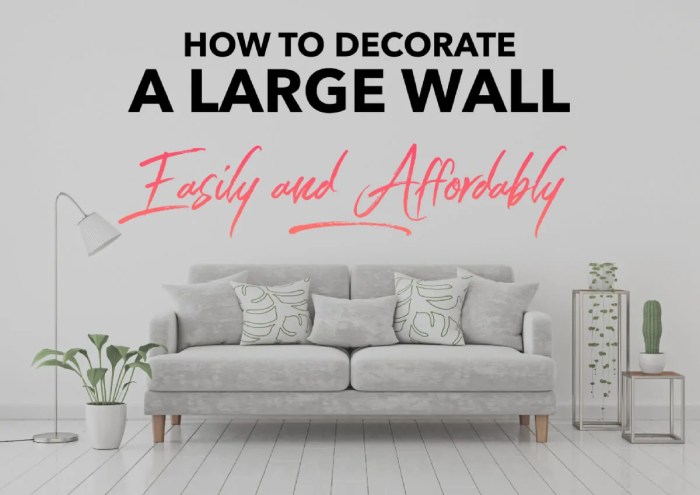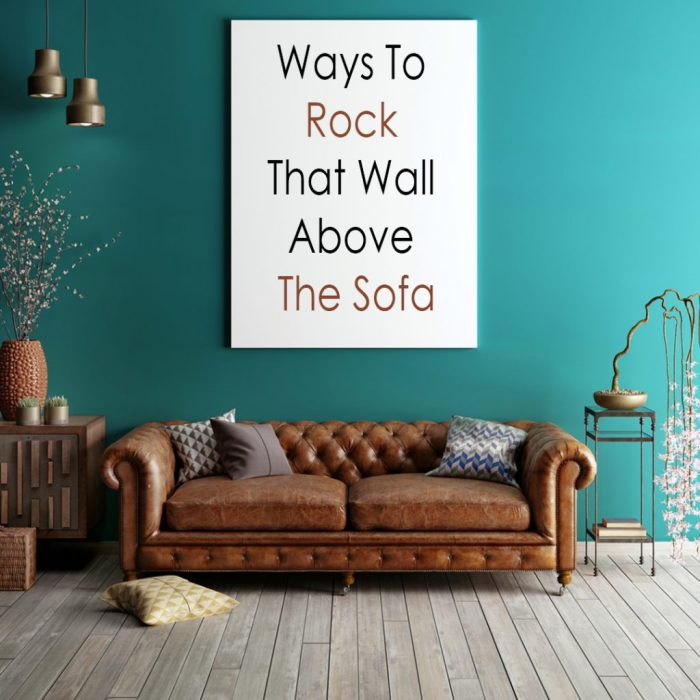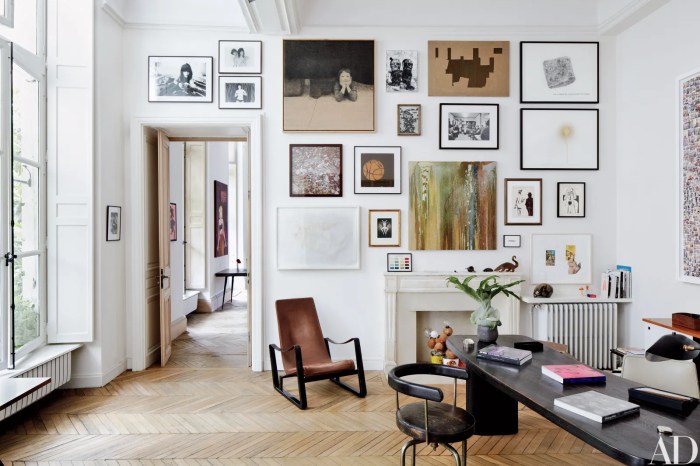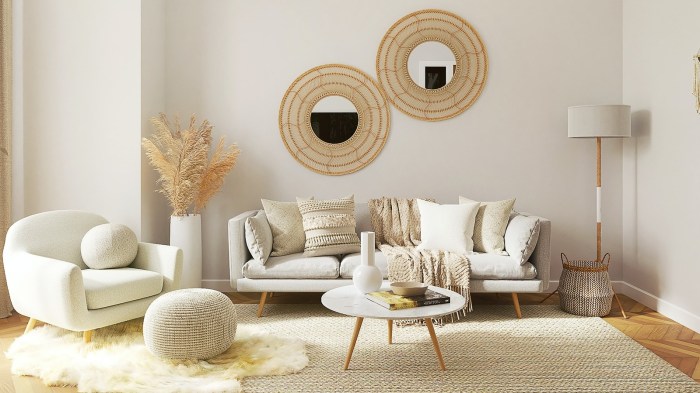Transforming a space from bland to breathtaking often hinges on the strategic use of wall art. This guide delves into the art of decorating with wall art, exploring various styles, arrangement techniques, and considerations for creating a cohesive and impactful aesthetic. From selecting the perfect piece to mastering gallery wall layouts and incorporating lighting, we’ll equip you with the knowledge to elevate your interior design.
We will cover a range of topics, from understanding different art styles and their suitability for various rooms to employing budget-friendly DIY techniques. The process of choosing the right size and scale of artwork, integrating it with existing decor, and avoiding common decorating pitfalls will be addressed in detail. By the end, you’ll be confident in your ability to create a visually stunning and personalized space through the thoughtful use of wall art.
Choosing the Right Wall Art

Selecting appropriate wall art is crucial for enhancing the aesthetic appeal and overall ambiance of a space. The right artwork can transform a room, reflecting personal style and creating a visually engaging environment. Careful consideration of style, material, size, and placement is essential to achieve a harmonious and impactful result.
Wall Art Styles and Their Characteristics
Various styles of wall art offer diverse aesthetic qualities and suit different interior design preferences. Understanding these differences is key to making informed choices.
| Style | Material | Cost | Best Room Placement |
|---|---|---|---|
| Paintings (Oil, Acrylic, Watercolor) | Canvas, wood panel, paper | Varies widely depending on artist, size, and medium; can range from affordable prints to very expensive originals. | Living room, dining room, bedroom (depending on subject matter and style) |
| Prints (Giclée, Lithograph, Screen Print) | Paper, canvas, metal | Generally more affordable than original paintings; cost varies depending on quality, size, and framing. | Any room; versatile and adaptable to various décor styles. |
| Photographs | Photo paper, canvas, metal, acrylic | Cost varies depending on size, printing method, and framing; readily available at various price points. | Entryway, hallway, living room, office (depending on subject matter and style) |
| Tapestries | Textile (cotton, wool, silk) | Cost varies widely depending on size, material, and craftsmanship; can range from affordable to very expensive. | Living room, bedroom, dining room (adds texture and warmth) |
| Sculptures | Wood, metal, stone, ceramic, glass | Cost varies greatly depending on material, size, and artist; can range from affordable small pieces to very expensive large-scale works. | Shelves, mantles, corners, or as standalone pieces in larger rooms. |
Selecting Wall Art to Complement Existing Décor
Successful wall art selection involves careful consideration of the existing décor and personal style. The artwork should enhance, not clash with, the overall aesthetic.Color palettes play a significant role. For example, a room with cool blues and greens might benefit from artwork featuring similar shades or complementary colors like oranges and yellows to create visual interest. Conversely, a warm-toned room with reds and browns could be enhanced with artwork in analogous colors or contrasting cool tones for balance.
Consider the existing design elements: if the room features geometric patterns, abstract art might complement the existing style, whereas a room with more traditional furniture might suit classic landscape paintings or still lifes. For a modern minimalist space, simple, clean-lined artwork is usually a better fit than highly ornate pieces.
Determining Appropriate Size and Proportions of Wall Art
The size and proportion of wall art significantly impact its visual impact. Overly small pieces can get lost, while overly large ones can overwhelm the space.
Consider these guidelines for selecting appropriately sized wall art:
- Large Walls: A large wall can accommodate a single, oversized piece of art or a gallery wall featuring multiple smaller pieces arranged strategically. A large landscape painting or a tapestry might be suitable for a large wall above a sofa or fireplace.
- Small Walls: A small wall may only accommodate a single, smaller piece of art. A small print or photograph in a simple frame would be appropriate for a small wall in a hallway or above a side table.
- Above Furniture: When placing art above furniture, aim for the artwork to be approximately two-thirds to three-quarters the width of the furniture piece. For example, above a sofa that is 80 inches wide, a piece of art between 53 and 60 inches wide would be a suitable size.
- Grouping Multiple Pieces: When creating a gallery wall, consider varying the sizes and shapes of the artwork for visual interest. Maintain a consistent theme or color palette to create cohesion. The total width of the gallery wall should generally be proportional to the wall space available.
Arranging Wall Art Effectively

Effective arrangement of wall art significantly impacts a room’s aesthetic appeal and overall atmosphere. The placement and grouping of artwork should complement the existing décor and reflect the homeowner’s personal style. Careful consideration of scale, spacing, and the interplay between different pieces is crucial for creating a visually harmonious and engaging display.
Gallery Wall Arrangements
Gallery walls, featuring a curated collection of various sized artworks, offer a dynamic and visually stimulating display. Successful gallery wall design hinges on careful planning and a cohesive theme. A well-executed gallery wall avoids appearing cluttered or haphazard, instead creating a unified and impactful statement. The key is to establish a balance between variety and unity.
- Consider the overall shape and size of the wall space: Before selecting artwork, measure the available wall area to determine the appropriate size and shape of the gallery wall. This will help guide the selection of pieces and their arrangement.
- Choose a cohesive theme or color palette: Selecting artwork with a common thread—be it subject matter, color palette, or artistic style—will create a sense of unity and prevent the gallery wall from appearing disjointed. A consistent frame style can further enhance this cohesiveness.
- Experiment with different arrangements: Before committing to a final arrangement, consider using tracing paper cutouts representing the size and shape of each artwork. This allows for easy experimentation and adjustments to achieve the desired balance and visual flow.
Sample Gallery Wall Layout:
- A large landscape photograph (30″ x 40″) centered at eye level.
- Two smaller abstract paintings (12″ x 12″) flanking the photograph, approximately 6 inches apart.
- A framed botanical print (16″ x 20″) positioned below the central photograph, slightly offset to the left.
- A set of three small framed prints (8″ x 10″) arranged in a vertical stack to the right of the botanical print.
Statement Piece Arrangements
A single, large-scale artwork can serve as a powerful focal point, commanding attention and setting the tone for an entire room. The selection and placement of a statement piece require careful consideration of scale, style, and the overall room design. The artwork should be proportionate to the wall space, avoiding overwhelming or appearing lost in the expanse.
Symmetrical Layouts
Symmetrical arrangements create a sense of balance and order, often lending a formal and sophisticated feel to a space. This approach typically involves mirroring artwork or decorative elements on either side of a central point, such as a fireplace or window. The repetition creates visual harmony and a sense of equilibrium. However, perfect symmetry can feel too rigid; slight variations can add visual interest without sacrificing the overall balance.
Enhancing Wall Art with Frames and Matting
Frames and matting play a crucial role in enhancing the presentation of artwork. Frames not only protect the art but also contribute significantly to its aesthetic appeal. The frame’s style, color, and material can dramatically alter the overall look and feel of the piece.
- Ornate frames add a touch of elegance and formality, complementing classical or traditional styles.
- Minimalist frames, often featuring simple lines and neutral colors, suit modern and contemporary settings.
- Wide matting can create visual breathing room around the artwork, drawing attention to the piece itself, and is particularly effective for smaller works or those with delicate details.
Incorporating Lighting to Highlight Wall Art
Proper lighting can dramatically enhance the visual impact of wall art, bringing out its colors, textures, and details. Both natural and artificial light sources can be effectively utilized.
- Natural light: Positioning artwork near windows to benefit from natural light is ideal, however, direct sunlight should be avoided as it can cause fading. Soft, diffused light is most flattering.
- Artificial light: Track lighting, picture lights, or strategically placed spotlights can be used to highlight specific pieces, creating dramatic effects. Avoid harsh, overhead lighting that can cast unwanted shadows.
Considering the Room’s Ambiance

Wall art significantly impacts a room’s mood and atmosphere, acting as a powerful tool in interior design. The careful selection and placement of artwork can transform a space, setting the tone and influencing how occupants feel and interact within it. Understanding this relationship allows for the creation of intentional and aesthetically pleasing environments.The style of art directly correlates with the ambiance it creates.
Abstract pieces with vibrant colors and bold strokes can inject energy and dynamism into a room, while minimalist artwork in muted tones can foster a sense of calm and tranquility. Similarly, classic or traditional art can lend an air of sophistication and elegance, whereas modern or pop art pieces can create a playful and contemporary feel. The texture of the artwork itself also contributes; a rough, textured piece can add visual interest and a rustic charm, while smooth, polished surfaces can contribute to a more refined and polished look.
Wall Art as a Functional Element
Strategic placement of wall art can enhance the functionality of a room by creating visual focal points and adding personality. Well-chosen artwork can guide the eye, draw attention to specific areas, and contribute to the overall narrative of the space.
- In a living room, a large, captivating piece above the fireplace or sofa can serve as a stunning focal point, drawing the eye and anchoring the room’s design.
- In a bedroom, a gallery wall of smaller, personal pieces can add a touch of individuality and create a cozy, intimate atmosphere.
- In a dining room, a piece of art that complements the table setting and overall décor can enhance the dining experience, creating a more sophisticated and inviting ambiance.
- In a home office, a piece of inspirational art or a calming landscape can help to create a productive and stress-free workspace.
Room Size and Architectural Considerations
The scale and style of artwork should be carefully considered in relation to the room’s size and architectural features. Overly large pieces in small rooms can feel overwhelming, while small pieces in large rooms can appear lost and insignificant. Similarly, the artwork should complement the architectural details of the room, such as high ceilings, large windows, or intricate molding.
For instance, a large-scale piece might be suitable for a room with high ceilings, while a smaller grouping of artwork might be more appropriate for a room with lower ceilings.
| Room Size | Suitable Wall Art |
|---|---|
| Small (e.g., bathroom, hallway) | Single, smaller piece; a collection of smaller, framed prints; a mirror |
| Medium (e.g., bedroom, dining room) | Medium-sized piece as a focal point; a gallery wall of varying sizes; a tapestry |
| Large (e.g., living room, master bedroom) | Large-scale artwork; a triptych; a series of large canvases; a mural |
Creating a Cohesive Look
Creating a cohesive look with wall art involves thoughtfully selecting pieces that work together to tell a story or establish a specific mood within a space. This goes beyond simply choosing aesthetically pleasing individual pieces; it’s about creating a visual harmony that enhances the overall design of the room. Careful consideration of themes, color palettes, and the integration of art with other decorative elements are key to achieving this.
Theme Development and Art Selection for a Living Room
A cohesive theme provides a unifying element for a collection of wall art. For a living room, consider a theme centered around “Tranquil Nature.” This theme evokes calmness and serenity, perfect for a relaxing space. To achieve this, a curated collection of artwork could include: a large landscape painting depicting a serene forest scene; a set of smaller botanical prints featuring various wildflowers; a textured abstract piece in muted greens and blues, echoing natural tones; and a framed photograph of a peaceful mountain range.
These pieces, while diverse in style, share a common thread of natural imagery and a calming color palette, creating a unified visual narrative.
Integrating Wall Art with Other Decorative Elements
Wall art shouldn’t exist in isolation; it should be thoughtfully integrated with other decorative elements to create a holistic design. For instance, the colors in a painting can be echoed in throw pillows or a rug, creating a visual connection. A rustic wooden frame complements a farmhouse-style living room, while a sleek, minimalist frame suits a modern aesthetic. Consider the following examples: a vibrant abstract painting can be complemented by similarly colored accent chairs and cushions; a black and white photography series can be paired with monochrome accessories and a neutral-toned sofa; a collection of travel posters can be enhanced by the inclusion of travel-themed decorative objects, such as souvenirs or globe.
The key is to establish a visual dialogue between the wall art and the rest of the room’s decor.
Common Mistakes in Wall Art Decoration and Their Solutions
Overcrowding and mismatched styles are common pitfalls in wall art decoration. Careful planning and a considered approach can prevent these issues.
| Mistake | Solution |
|---|---|
| Overcrowding the walls with too many pieces, creating a cluttered and overwhelming effect. | Curate a smaller, more focused collection of art pieces. Allow for sufficient white space between pieces to prevent visual overload. Consider using a single, large statement piece instead of multiple smaller ones. |
| Mixing drastically different art styles (e.g., modern abstract alongside Victorian-era portraits) without a unifying element, resulting in a disjointed and visually jarring space. | Establish a unifying theme or color palette. If mixing styles, ensure there’s a common thread, such as color, texture, or subject matter, that ties the pieces together. Consider using similar framing styles to create visual consistency. |
| Hanging art too high or too low, disrupting the visual flow and diminishing the impact of the artwork. | Hang artwork at eye level, generally between 57 and 60 inches from the floor. Consider the size and scale of the artwork in relation to the furniture and the overall room dimensions. |
| Ignoring the scale of the artwork in relation to the wall and furniture, leading to an unbalanced or disproportionate look. | Choose artwork that is appropriately sized for the wall space. A large piece might overwhelm a small wall, while a tiny piece might get lost on a large wall. Consider the proportions of the artwork in relation to the surrounding furniture. |
DIY and Budget-Friendly Options

Transforming your living spaces with captivating wall art doesn’t necessitate a hefty budget. Numerous creative and affordable DIY projects can breathe new life into your walls, reflecting your personal style without breaking the bank. This section explores simple techniques and readily available materials to craft unique and visually appealing wall art.
Creating a Simple Collage
Collages offer a versatile and inexpensive way to showcase cherished memories, inspiring quotes, or vibrant patterns. Begin by gathering materials such as various-sized photographs (printed from digital files or sourced from old albums), magazine cutouts, patterned papers, and textured fabrics. Choose a backing material, like a large piece of cardstock, foam board, or even a repurposed canvas. Arrange your chosen elements on the backing, experimenting with different layouts until you achieve a pleasing composition.
Once satisfied, use a strong adhesive like glue sticks or photo mounting squares to secure the pieces. For added visual interest, consider incorporating small embellishments such as ribbons, buttons, or dried flowers. Finally, protect your finished collage with a sealant spray to prevent damage and enhance longevity. This simple process allows for endless customization, resulting in a unique piece of wall art that reflects your individual aesthetic.
Repurposing Existing Items
Existing household items often hold untapped potential for creating unique wall art. Old picture frames, for example, can be transformed into decorative pieces with minimal effort. Remove any existing artwork and clean the frames thoroughly. Depending on the desired aesthetic, the frames can be painted, decoupaged with patterned paper or fabric, or adorned with small objects like shells, buttons, or dried flowers.
Alternatively, use the frames to display pressed flowers, textured fabrics, or even small mirrors, creating a visually interesting and eclectic display. Similarly, fabric scraps can be easily transformed into wall art. Simple patchwork designs can be created by sewing together various fabric scraps, creating a vibrant and textured piece. Alternatively, fabric can be stretched and stapled onto a wooden frame, creating a modern and minimalist look.
These repurposing projects offer a sustainable approach to decorating while showcasing creativity and resourcefulness.
Finding Affordable Prints and Artwork
Numerous resources exist for discovering affordable and high-quality prints and artwork, both online and offline. Online platforms such as Etsy, Society6, and Redbubble offer a vast selection of prints from independent artists, often at competitive prices. These platforms provide a diverse range of styles and subjects, ensuring that you can find something to suit your personal taste. Additionally, many online print-on-demand services allow you to create custom prints using your own photographs or designs.
Locally, thrift stores, antique shops, and flea markets can be treasure troves of affordable artwork. Often, you can find unique pieces at a fraction of the price of new artwork. Furthermore, local art galleries or studios may occasionally hold sales or offer prints from emerging artists at accessible price points. By exploring both online and offline resources, you can find affordable and high-quality prints that enhance your living spaces without exceeding your budget.
Ultimately, decorating with wall art is a journey of self-expression and creative exploration. By carefully considering the style, arrangement, and overall ambiance of your space, you can transform your walls into captivating displays that reflect your personality and enhance your living environment. Remember, the key lies in thoughtful selection, strategic placement, and a cohesive vision that brings your interior design to life.
Experiment, personalize, and enjoy the process of creating a space that truly speaks to you.
FAQ
What are some common mistakes to avoid when hanging wall art?
Common mistakes include hanging art too high, neglecting proper spacing between pieces, using frames that clash with the existing décor, and overcrowding a wall with too many pieces.
How can I determine the best lighting for my wall art?
Consider both natural and artificial light sources. Natural light can highlight texture and color, while strategically placed spotlights or picture lights can emphasize specific pieces in low-light areas. Avoid harsh overhead lighting that creates glare.
Where can I find affordable, high-quality wall art?
Explore online marketplaces like Etsy and Society6, visit local art fairs and galleries, or consider thrift stores and antique shops for unique, budget-friendly options.
How do I choose wall art for a small room?
Opt for smaller-scale pieces to avoid overwhelming the space. Lighter colors and less cluttered designs can help create a sense of openness. Consider a single statement piece rather than a gallery wall.
What is the best way to hang a heavy piece of wall art?
Use heavy-duty hanging hardware appropriate for the weight of the artwork and the wall type. Consider using multiple hanging points for extra support and stability.
Leave a Reply